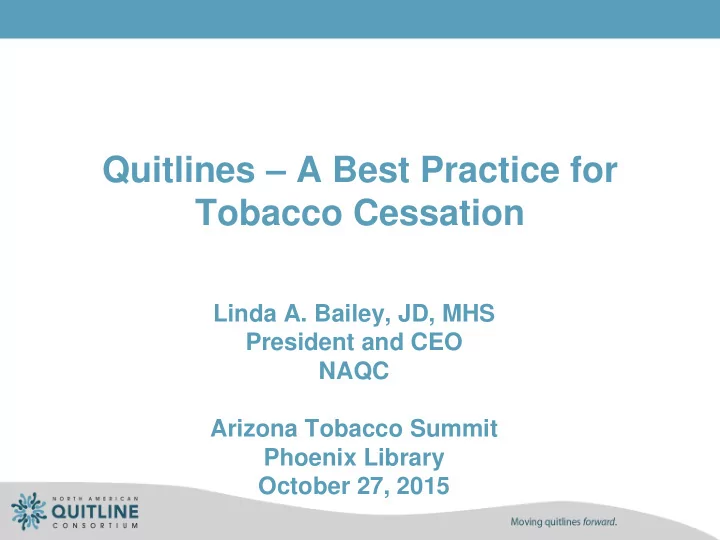

Quitlines – A Best Practice for Tobacco Cessation Linda A. Bailey, JD, MHS President and CEO NAQC Arizona Tobacco Summit Phoenix Library October 27, 2015
Overview • Benchmarks & milestones • Role of quitlines in advancing cessation • Challenges and opportunities
Cessation benchmarks Smokers interested in quitting 69% Past year quit attempts 55% Used counseling and/or meds 32% Prevalence of cessation in past yr 6% Source: MMWR, Quitting Smoking Among Adults — United States, 2001 – 2010, November 11, 2011 / Vol. 60 / No. 44
Past year quit attempts (BRFSS) 2010: 57% in AZ 2013: 67% in AZ Source: Lavinghouze et. al. Trends in Quit Attempts Among Adult Cigarette Smokers — United States, 2001 – 2013. MMWR. October 16, 2015 / 64(40);1129-35
25 years of milestones 1988 First quitline services developed (GHC, NCI) 1992 SH Zhu article, CA launches first state quitline 1996 AZ, MA, OR quitlines established 1998 MSA funds distributed to states 2002 38 state quitlines 2004 NAQC begins, CDC/NCI create national network 2005 53 state quitlines exist 2008 CDC best practices and US PHS Clinical Practice Guide published 2014 CDC best practices update 2015 USPSTF update on cessation
State Quitline Services Treatment and Support Proactive counseling (100% of state quitlines) Medications (85% of state quitlines) Self-help materials (100% state quitlines) Chat rooms, texting, online programs (varies) Referral Programs and Training Fax referral (100%) eReferral to/from EHRs (pilots underway) Training in tobacco cessation counseling (all)
Quitline benchmarks, 2013 Metric Actual _________ Total number of calls 1.3 million Calls from tobacco users 487,846 Referrals 184,358 Callers rec’ing tx 427,848 Expenditures (nationally) $125.5M Benchmarks 2015 Goals Treatment reach 1.08% 6% State investment per smoker $1.69 $10.53 Quit rate 31.6% 30% Source: NAQC Annual Survey of Quitlines,www.naquitline.org/?page=2013Survey
Total & Median Calls to State Quitlines: FY2005 – FY2013 1600000 18000 16000 1400000 14000 1200000 12000 1000000 10000 800000 8000 600000 6000 400000 4000 200000 2000 0 0 FY2005 FY2006 FY2008 FY2009 FY2010 FY2011 FY2012 FY2013 Total Calls Median # of Calls
Median and Total (sum) State Quitline Budgets $140,000,000 $1,800,000 $1,600,000 $120,000,000 Total Quitline Budget (sum) $1,400,000 Median Quitline Budget $100,000,000 $1,200,000 $80,000,000 $1,000,000 $800,000 $60,000,000 $600,000 $40,000,000 $400,000 $20,000,000 $200,000 $0 $0 FY2007 FY2008 FY2009 FY2010 FY2011 FY2012 FY2013 Total Quitline Budget (sum) Median Quitline Budget
Challenges & opportunities Dynamic Landscape . . . Affordable Care Act …. Role of state, health plans, employers in providing and paying for quitlines Meaningful Use …. Partnership with healthcare Changing face of smokers …. Need to be more consumer-oriented, better outreach, new technologies New non-combustible products …. Impact on cessation?
Implications of ACA - Insurers and health plans become responsible for providing cessation treatment to all insured/members with no co-pay - Makes the “pie” bigger, should increase availability, use of cessation services - For quitlines: - Educating private insurers/health plans about the importance of cessation services - Offering cost-sharing for private insurers and Medicaid
60% of State Quitline Users Were Insured in FY2012 Private Insurance, 25% Uninsured, 40% Other Government Insurance, 11% Medicaid, 24%
More than one-quarter of US quitlines are restricting or considering restrictions on services for insured callers 100% 90% 80% 70% 60% 54% 50% 40% 27% 30% 20% 12% 10% 0% Yes No Don't know/unsure
Cost sharing exists, or is in progress, for 24 US quitlines in FY2013 30 27 24 25 20 15 10 5 0 Yes No
Current methods offered to providers to refer patients to quitlines 100% 94% 90% 83% 80% 70% 60% 50% 42% US (n=53) 36% 40% Canada (n=12) 30% 21% 20% 8% 10% 0% Faxed Form Email or online EMR with electronic submission
Treatment reach by population Proportion of Smokers Rec’ing Counseling/Meds Population General Population 1.1% African-Americans 1.0% Am. Indian/Alaska Native 0.8% Asian 0.5% Hispanic/Latino 0.6% Low SES 0.9%
Recommendations for Increasing Reach & Treatment to Priority Pops State agencies should : - Develop partnerships with entities based where priority pops live - Provide list of local resources, within community for smokers - De-mystify quitlines through better communications with healthcare clinics and community orgs - Increase recruitment, marketing and outreach to pops, especially Medicaid
Recommendations for Increasing Reach & Treatment to Priority Pops Quitlines should: - Explore new technology for improving reach, use targeted messages and multiple modes of contact - Enhance referral systems to increase the number of calls and referrals - Support use of NRT and adherence - Increase the number of counseling sessions - Make better use of in-language counseling, especially for Spanish and Asian language speakers
Quitlines and E-Cigarettes/ENDS • Growing interest in and questions about e-cigs among callers to quitlines (quitting, risk reduction) • Will e-cigs/ENDS be a game changer? • Need for science, regulation
Concluding Points • Cessation is a key component for reducing prevalence • Implementation of ACA must result in more, not less, effective cessation service for those seeking to quit (including quitlines and face to face treatment). • Quitlines must focus on: • Educating insurers/health plans about importance of cessation/quitlines and ACA requirements on cessation • Improving reach and service to priority populations • Partnership between healthcare and quitlines
Recommend
More recommend